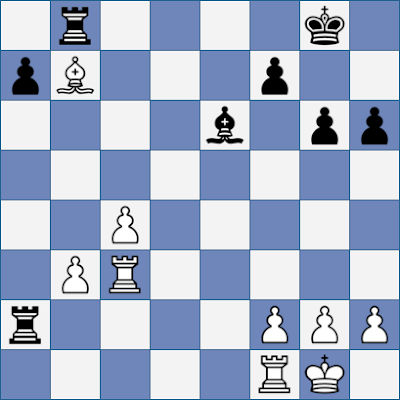BtM 8A: From the endgame into the opening
April 1988, Position F
White to play
Uhlmann - Schmidt, Polanica Zdroj 1975
and
Uhlmann - Schmidt, East Germany v Poland 1981
Contributions are welcome in the comments box. I’ll reply with what the Masters have to say about their choice to anybody who suggests a move.
Scroll down to see some commentary from me and the Masters’ feedback.
.
.
.
.
.
.
.
.
.
.
.
.
.
.
.
.
.
.
.
.
A couple of weeks ago, I started adding tags to these posts for position type. I thought one day somebody might want to look at just the middlegames, say, or perhaps just the endgames.
I doubt anyone would quibble with me tagging today’s puzzle as an endgame. Maybe it should really be an opening, though. Not when Uhlmann and Schmidt first played it in 1975, maybe, but when they got there the second time six years later.
.
.
.
.
.
.
.
.
.
.
.
.
.
.
.
.
.
.
.
.
POINTS
10: Be4
9: Bc6, Bf3
5: Bd5
MASTERS
Be4: Flear, P. Littlewood, Conquest
Bc6: Kosten, Norwood, Levitt, K. Arkell, J. Littlewood, Horner, S. Arkell, Fidelity Mach 2
Bf3: Howell, Pein
SOURCE
Bc6, Uhlmann - Schmidt, Polanica Zdroj 1975
Be4, Uhlmann - Schmidt, East Germany v Poland 1981





I was inclining towards 1. Be4 over 1. Bc6 but hadn’t worked things out.
ReplyDeleteWhite presumably wants to be able to defend his pawn on b3 and has to choose where to place the bishop to do this. 1. Bc6 aims for Ba4 while 1. Be4 prepares Bc2. Ba4 looks more active but what I didn’t like about it was that Black could still target b3 – through Rb8 and by playing ... Rb2 and either ... Bf5-c2 or ... Bf5-b1-a2 – that said, in marshalling his pieces to attack b3, Black has to be careful about losing sight of White’s passed c pawn. A bishop on c2 on the other hand, while looking passive and making Rc3 awkward, could deter Black’s bishop from coming to f5 and would keep the a-file open, possibly allowing ... Rb2 to be countered with Ra1.
Hmm... Maybe after 1. Be4 White can just defend against ... Rb2 with Rb1 - no need for the bishop to come back to c2.
Delete10 more points Angus.
ReplyDeleteFlear justified 1 Be4 on the grounds that it allowed Rb1 by taking control of the b1-h7 diagonal. Paul Littlewood’s analysis was a bit different:
"... my decision is based on 1 ... Ra3, 2 Bc2 a5, 3 Re3 and White remains a pawn up though he was many difficulties."
Presumably Schmidt felt the position was defendable given that he played into it a second time.
Uhlmann, btw, played 1 Bc6 in 1975 and 1 Be4 in 1981.
Against 1 Bc6 the BTM editor considers ... Ra3 with ... Rb4 to come an effective defence.